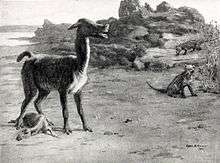Borhyaena
| Borhyaena Temporal range: Early Miocene | |
|---|---|
| | |
| B. tuberata skull | |
| Scientific classification | |
| Kingdom: | Animalia |
| Phylum: | Chordata |
| Class: | Mammalia |
| Infraclass: | Metatheria |
| Order: | †Sparassodonta |
| Family: | †Borhyaenidae |
| Genus: | †Borhyaena Ameghino, 1887 |
| Species | |
| |
Borhyaena is an extinct genus of South American metatherian, living between 20 and 15 million years ago in Patagonia, Argentina. Borhyaena was a predator and had a large head and a long, powerful neck similar to living hyenas, its legs were cursorial, albeit less specialized than those of wolves or the marsupial thylacine. The most complete specimen is estimated to have weighted 23 kilograms (51 lb) and stood 50 centimetres (1.6 ft) at the shoulders.[2]

Restoration of Theosodon garretorum and Borhyaena tuberata
References
- ↑ Marshall, Larry G. (1978). "Evolution of the Borhyaenidae, extinct South American predaceous marsupials". 117. University of California Press: 1–89.
- ↑ Argot, C. (2003). "Functional adaptations of the postcranial skeleton of two Miocene borhyaenoids (Mammalia, Metatheria), Borhyaena and Prothylacinus, from South America.". Palaeontology. 46 (6): 1213–1267. doi:10.1046/j.0031-0239.2003.00339.x.
This article is issued from Wikipedia - version of the 7/27/2016. The text is available under the Creative Commons Attribution/Share Alike but additional terms may apply for the media files.